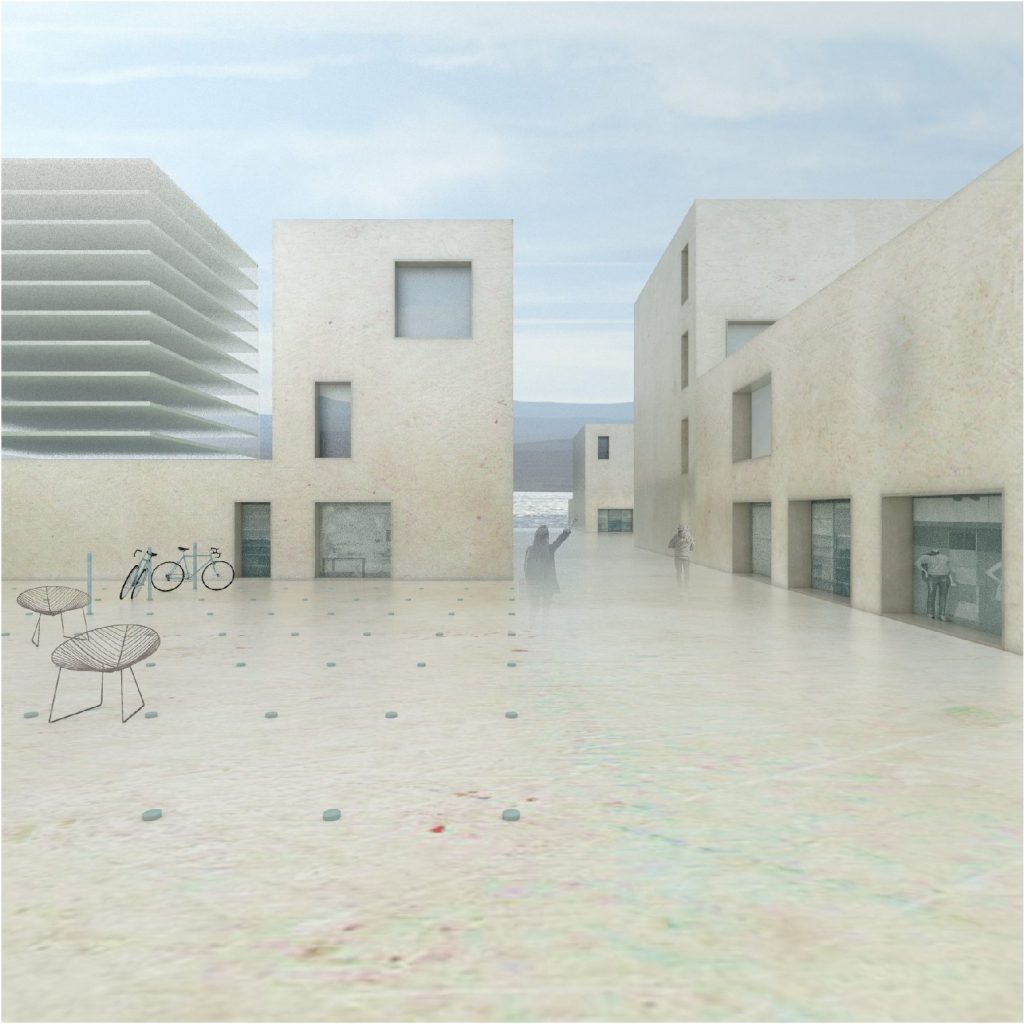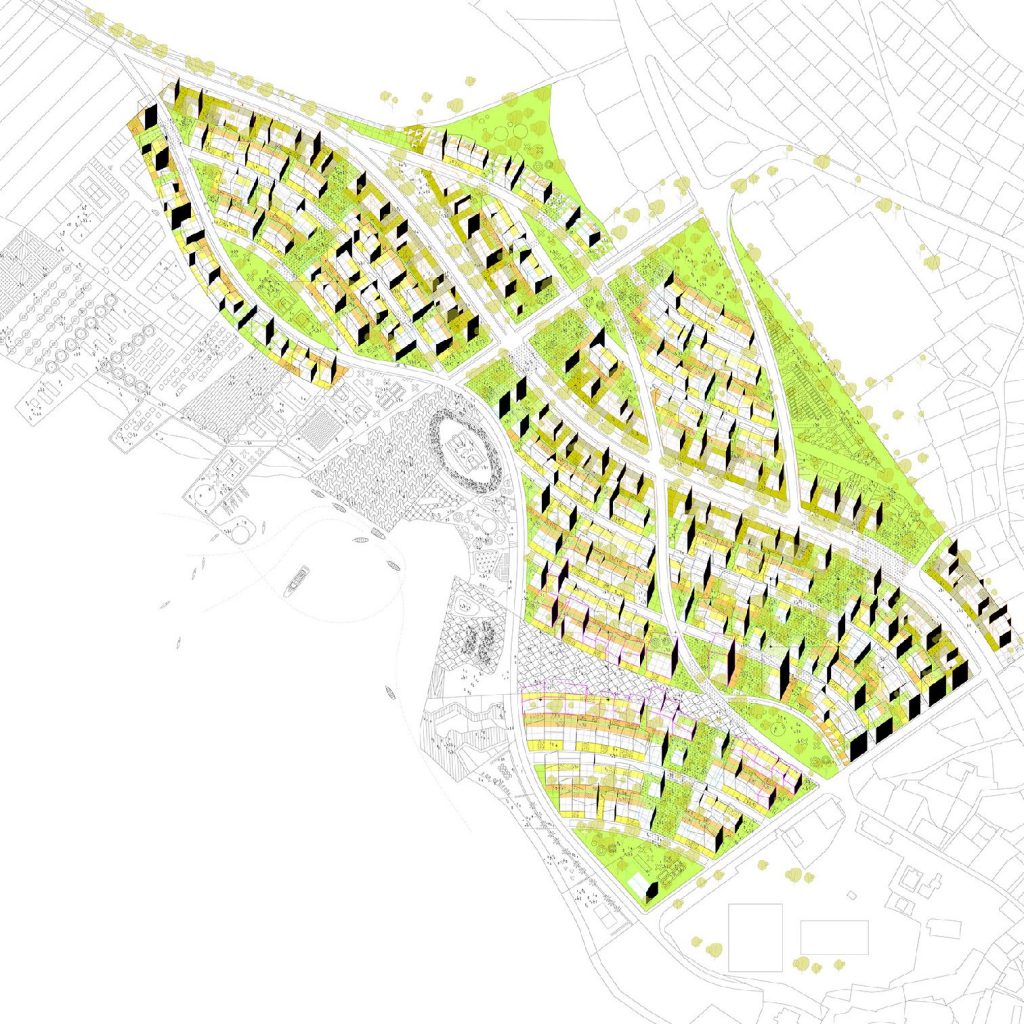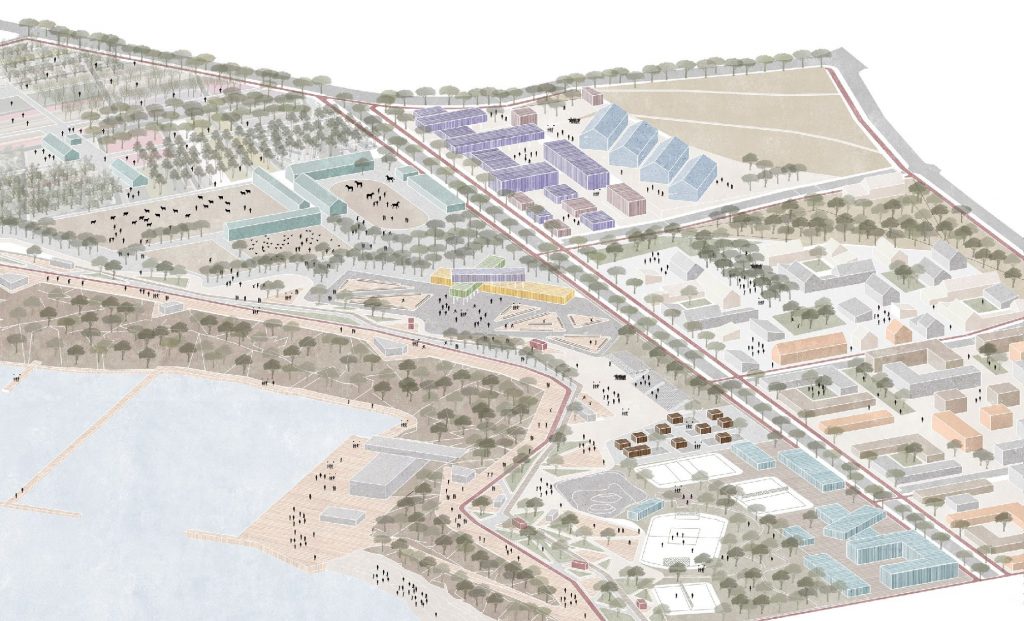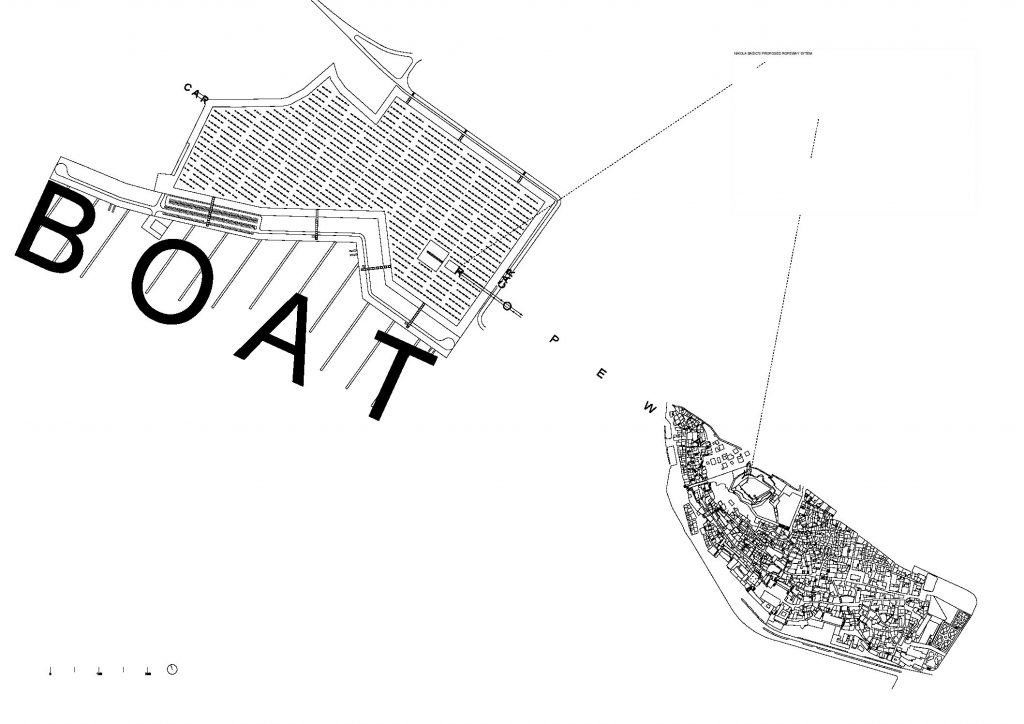Europan 14
Europan 14 : Productive Cities
After Two Sessions Exploring the Adaptable City
Europan Now Focuses on Productive Cities
How mixed is actually the mixed-city? Housing remains the main program in many urban development projects of the post-industrial era. We wisely add some office places and public amenities, but remain especially keen on stimulating bars, shops and restaurants because we want every new district to be a “genuine vibrant urban neighbourhood. Looking back at how we organized this wave of regeneration, we can see how we have systematically excluded one program: the productive economy.
There is now in many European cities a spatial and social mismatch between living and working conditions. The city provides high-skilled professionals with many working possibilities while a large part of low-skilled workers live in the city with no work opportunity. This mismatch generates many problems with regard to economy, mobility and sociality.
Of course, we should not bring steel factories back to the city centre. But we are already welcoming all kinds of small-scale urban manufacturing. We are accommodating more and more of the new recycling industry within the city itself. We could systematically save some space in our programs for redevelopment areas for small and medium enterprises. We should avoid that the plumber living in the city and repairing our houses in the city has to drive out of the city to find available storage space. Production should be encouraged in the city, be part of the fabric, be allowed to be seen, connected to shared daily life, nurtured and celebrated. Which alternatives should we produce for such a city?
How to integrate some of the production activities in the city–such as the production of food, energy, low skilled services, new industrial products–to enhance new relations between citizens?
How to live in productive fields and to produce in living environment?
How to integrate all the production cycles considering distribution, waste and consumption?
The challenge for Europan 14 is to generate new kinds of proximity by connecting the living and the producing.
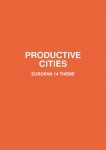
Šibenik
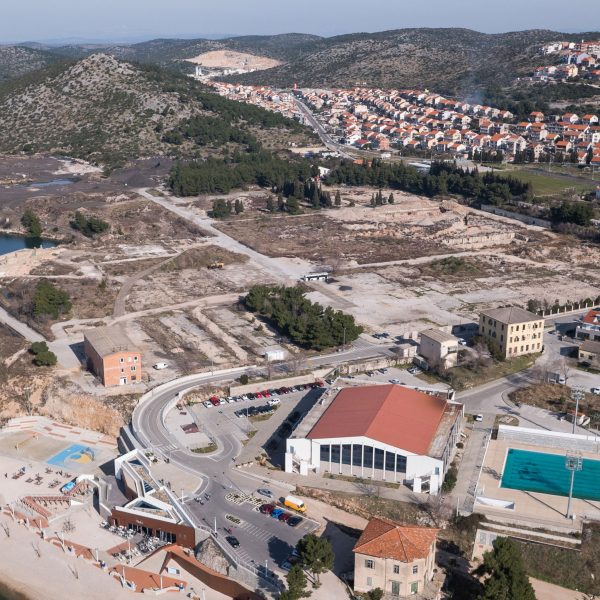
Location: Šibenik
Population: 46,332 inhab.
Strategic site area: 173 ha
Project site area: 33 ha
Site proposed by: City of Šibenik (municipality)
Owner(s) of the site: City of Šibenik (municipality)
Post-competition phase: Urban study, masterplan
Team representative: Architect, urban planner
How can the site contribute to the productive city?
The City of Šibenik base its prosperity on entrepreneurship, industry, tourism and good transport connections. Development priorities of Šibenik are directed towards the development of productive activities and the development of supporting structures.
Development of the designated area into a new residential area, with commercial and tourist spaces, high urban standards and values, supporting urban functions, social infrastructure and with their integration into a solid, high quality public space; will contribute to the transformation of the whole area and to achieving the productive city.
City strategy
Šibenik has recently started a transition from the industrial town into the attractive tourist destination. One of the projects that are in accordance with the City’s orientation to the tourism development is Project TEF (for “Tvornica elektrometala i ferolegura”, i.e. “Electrodes and Feralloys Factory”).
According to General urbanistic plan of Šibenik, it is required to make an urbanistic development plan for TEF which will precisely define the future use of the entire space. With a proper organization of the space, project area should upgrade and thus extend the city centre itself, as well as serve as a model of a transformation of an industrial zone into a new area of high-quality urban living. Former TEF area thus becomes an extension of the city centre.
Site definition
The project site, former Electrodes and Feralloys Factory (TEF), is located near the western entrance of the city and therefore represents the key potential of the city’s development. Located on the coast and near the old city centre makes it the prime location in the city of Šibenik.
This area used to be an old city neighbourhood and it ended up on the outskirts because the factory limited any expansion. Now that the factory was removed and after the entire location is refurbished, we have the possibility to expand the city and commercialise the land as well as the naval and coastal belt around it, since the channel in front of the former factory leads directly towards Skradin and the entrance of National Park Krka.
According to the Spatial development plan of the City of Šibenik and General urbanistic plan of Šibenik the land is defined as mixed use zone for commercial, residential or tourism/residential purpose.
How is Production Considered in the Urban Diversity Program?
The former Electrodes and Feralloys Factory stopped its production in 1994, which was immediately followed by its dismantling and land remediation. The former backbone of Šibenik’s economy today serves as a place where fairs, concerts and similar events are held. Because it is located near the western entrance to the city of Šibenik, it represents the key potential of the city’s development. This attractive location which includes great traffic connections and attractive environment of urban areas and tourist centers makes the former TEF site extremely attractive for future investments.
Except the possibility of building residential and commercial facilities within the construction zone, it is possible to restore green surfaces (parks, forest parks, protective (buffer) green zones), as well as other facilities and surfaces which are needed for the normal functioning, with the purpose of restoring and protecting the environment. This allows construction of traffic and pedestrian paths, bicycle paths, sport and recreation areas and playgrounds, smaller service, hospitality and commercial facilities. Port for nautical tourism is also planned on the location.
With the affirmation of the area by transforming it into a smart planned space, City of Šibenik has the opportunity to develop tourism or other economic zones which will complement others in the city of Šibenik.
Entry Conditions
Entrants
Europan 14 is open to any team consisting of one architect in partnership or not with one or more professionals of the same or other disciplines of the urban-architectural field (architects, urban planners, landscapers, engineers, artists…)
Every team member, whatever his/her profession, must be under the age of 40 years old on the closing date for submission of entries.
Composition of the Teams
There is no limit to the number of participants per team. Multidisciplinarity is strongly recommended with regards to the sites issues.
A registered team can modify its composition on the European website until the closing date for submissions. No further change shall be accepted after this date.
Each team member (associate and collaborator) shall be registered as such on the European website before the closing date for submissions.
One team can submit a project on different sites and one person can be part of different teams provided that the projects are submitted in different countries.
Associates
Associates are considered to be authors of the project and are credited as such in all national and European publications and exhibitions. They are young professionals with a university degree recognised by the Directive 2005/36/EC of the European Parliament and of the Council of 7 September 2005 on the recognition of professional qualifications, in any of the relevant disciplines and regardless of nationality. The compulsory requirement is to hold such a degree.
Membership in a European professional body is optional, except for associates without a European degree.
Contributors
Teams may include additional members, called contributors. Contributors may be qualified or not but none of them shall be considered as an author of the project. Just like the associates, the contributors must be under the age of 40 years old on the closing date for submission of entries.
Team Representative
Each team names one Team Representative among the associates: the Team Representative is the sole contact with the national and European secretariats during the whole competition. Furthermore, every communication shall be done with one sole email address, which shall remain the same during the whole competition.
The Team Representative must be an architect or must have the architect status under the laws of a European country. In specific cases and when mentioned on the site definition (see Synthetic Site File), the Team Representative can be an architecture, urban or landscape professional (architect, landscaper, urban planner, architect-engineer). In this case the team shall necessarily include at least one architect among the associates.
Non-Eligibility
No competition organizer is eligible to take part in the competition – neither are their employees and members of their families.
Are considered as organizers: the members of the Europan structures; the representatives of the sites proposed in the current session; the members of technical committees; the observers; and the jury members.
Registration
Registration is done on the European website – www.europan-europe.eu – and implies the acceptance of the competition rules.
In compliance with French Act #78-17 of Jan. 6th, 1978, on Information Technology, Data Files and Civil Liberties the protection of personal data communicated during registration is guaranteed.
Europan 14 Website
The European website for the fourteenth session of the competition is available online from the opening date of the competition, at the following url – www.europan-europe.eu
It includes: the complete European rules for the Europan 14 competition; the session topic; the Synthetic and Complete Site Files grouped geographically or by themes; the juries compositions; and an organisational chart of all the Europan structures.
The website also offers the possibility to register to the competition and submit the complete proposals.
Team Registration
Registration to the competition is done through the European website (Registration section) and implies the payment of a €150 fee. There shall be no refund of the registration fee.
The fee includes access to one Complete Site File and the printing of the panels –necessary for the evaluation– on a rigid support by the national secretariats.
Payment is automatically confirmed on the website. The team can then access a personal area and the digital entry area, and download the Complete Site File for the selected site.
An additional Complete Site File costs €50 per site.
Information Available to Teams
Synthetic Site Files – Free Download
The Synthetic Site Files present a summary vision of the site. They are available for free on the site presentation pages of the European website and help the teams select their project site(s).
This document is in English and sometimes also in the site language.
The Synthetic Site Files provide for each site:
Good-quality iconographic documents:
- 1 map of the city or conurbation identifying the location of the study site and giving the graphic scale;
- 1 aerial picture of the study site in its context identifying the location of the study site in red and the project site in yellow;
- 1 oblique aerial picture (semi-aerial) of the study site;
- 1 oblique aerial picture (semi-aerial) of the project site;
- 1 map of the area identifying the study site and the graphic scale;
- 1 map of the area identifying the project site and the graphic scale;
- at least 3 to 6 ground-level pictures showing the site’s characteristic elements (topography, natural features, existing architecture);
Written information:
- the site category;
- the profile of the team representative: architect or professional of the urban design;
- names of the town and place; population of the town and conurbation; surface area of the study and project sites; representative of the site; site owner(s); expected follow-up after the competition;
- the developer’s and the city’s specific objectives; strategic issues of the site; relation to the session topic: “Productive Cities”.
Briefs – Free Download
The Brief is a 10-to-15-page illustrated document, the aim of which is to provide a better understanding of the main elements of the context through the existing elements as well as through the site’s mutation issues and its environment. It is available for free on the site presentation pages of the European website and includes the following elements:
- A summary of the main elements of the site;
- The site specificities – site representative; others actors involved; function of the team representative; expected skills among the teams; post competition phase; operational mission;
- A detailed analysis of the regional and urban context, putting in perspective the transformations of the city and the region and including all the elements on this scale that may have a current or future influence on the site –mobility networks, ecological elements, urban structure, landscape, etc.– within the general framework of productive cities;
- A detailed analysis of the study site putting in perspective the transformation of the site (the site and its environment) and illustrating how the session topic is taken into account.
The following information is also provided:
– Role of the study site in the city policy, with details on the goals of the planning imagined by the municipality;
– Programmatic framework: planned transportation networks; public and private spaces to build and/or upgrade, with assumptions about planned functions and/or dimensions; goals for public spaces and infrastructures; and detailed explanations of the choices of the developers for each aspect of the programmes. - A detailed analysis of the project site putting in perspective the site transformation and the way to make it productive.
The programmatic framework is also detailed, with: the spaces to build and/or regenerate, with functions and dimensions; the precise goals for public spaces and infrastructures; detailed explanations of the developers’ intentions on the parts of the programmes to be included. - The main elements linked to the Europan 14 topic and their implication on uses and flexibility of spaces (built and public), natural elements and implementation processes of the mutation;
- A description of the sociocultural context of the site, the city and the region and its evolution to help participants better understand the local urban lifestyles and the citizens’ rhythms;
- A description of the economical context of the site, the city and the region and its evolution to help participants better understand the potential productive spaces to create.
This document is in English and sometimes also in the site language.
Complete Site Files
The Complete Site Files include detailed visual documents on the city, the site, the context as well as drawings, pictures and any graphic document required for the design process.
These Files are available on the site presentation pages of the European website after registration on the site and logging in to the website.
They include pictures, diagrams and graphics of the following scales:
a. Territorial Scale – Conurbation
- 1 aerial picture of the city;
- 1 map on regional (urban geography) or urban scale (conurbation) with an appropriate graphic scale showing the major features structuring the area (buildings, networks, natural features).
b. Urban Scale – Study Site
- 1 aerial picture of the study site;
- at least 1 semi-aerial picture of the study site;
- at least 5 ground-level pictures showing the characteristic features of the study site: topography, natural features, existing architecture, etc.;
- plans of the study site with an appropriate scale;
- characteristic features: infrastructure, existing and future plans, etc.
c. Local Scale – Project Site
- at least 3 semi-aerial pictures of the project site;
- at least 10 ground-level pictures showing the characteristic features of the project site: 5 topography, natural features, existing architecture, etc.;
- map(s) of the project site with an appropriate scale, showing:
– the project site’s location within the study site;
– the project site’s plot divisions, constructions, natural elements, etc.; - topographical map of the project site with an appropriate scale and, if necessary, characteristic features (buildings and natural features to be retained or not, etc.)
FAQ
Questions on the sites
A meeting is organised with the teams and the municipalities and/or developers on each site to give a detailed picture of the issues related to the site. The national structure of the site then publishes a report in English in a maximum of two weeks after the meeting. This report is available online on the site presentation pages of the European website.
In addition to this an FAQ section is open on each site webpage on the European website for a limited period of time (see calendar). Only the registered teams can ask questions on sites.
Questions on the rules
An FAQ section on rules is open on the European website for a limited period of time.
Submission of Entries
Digital Submission
Digital submission is compulsory. It includes the 3 A1 panels, documents proving the eligibility of the team members and documents for the communication of the project.
The complete submissions shall be submitted by midnight (Paris time) on June 30th, 2017, on the European website (Entry section).
Failure to comply with the hereunder-mentioned requirements on panel presentation may result in the disqualification of the team.
The number of entries per site is available on the European website on the European map of the sites (column on the right).
Anonymity and Compulsory Content
The site name and the project title must be displayed on every A1 panel.
A specific code is automatically attributed to each project upon upload. The teams do not know this code, through which the jury members take note of the project. The teams’ identities are revealed via an automatic link between the code and the team on the online projects database.
Language
The panels shall be either written in English or bilingual (English + the site language).
Items to Submit
Submissions include documents divided as follows:
- 3 vertical A1 project panels;
- Documents proving the eligibility of the team members;
- Documents for communication (3 images + a short text)
A1 Panels
Content – The 3 panels must:
- explain the urban ideas developed in the project with regards to the site issues and the themes of the session;
- present the project as a whole, highlighting the architecture of the project, and particularly the relationship between the new developments and the site’s existing context, including three-dimensional representations of the project
All graphic and descriptive documents must have a graphic scale.
Technical spectifications:
- PDF format;
- Vertical A1 (L 594 mm x H 841 mm) ;
- Maximum 20 Mb;
- One box (L 60 mm x H 40 mm) is left blank in the upper left corner for the automatic insertion of the code; the name of the city must be placed next to it;
- Panels numbered from 1 to 3 in the upper right corner;
- The team is free to decide on the positioning of the proposal title.
Documents to prove the eligibility of the team members
Documents for the disclosure of names and verification of the validity of the proposals shall be uploaded as PDF’s on the European website.
Personal information include:
- For the team: the Team Form and Declaration of Author – and Partnership and of Acceptance of the competition rules available online on the team’s personal area; to be filled out and signed;
- For each team member:
– A copy of an ID document with a picture, providing evidence that they are under the age of 40 at the closing date for submission of entries (see calendar.)
– A copy of their European degree as an architectural, urban or landscape professional (architect, landscaper, urban planner…) or proof of such a status under the law of a European country.
No other document than the ones above-listed is necessary.
Attention: The personal documents must be uploaded individually for each team member before the submission deadline. Only team members that correctly registered and submitted their eligibility documents separately shall be considered within the team final composition. The upload of one sole document with all the required information (copies of the ID’s and degrees) will not be accepted.
Documents for the project communication
Each project must be summered up as follows:
- One short text of maximum 2,500 signs (spaces included, to be typed in during submission);
- 3 separate PDF images that symbolize the project (max. 1Mb per image).
Control of the Submissions
Each team can check the upload of their projects on their online personal area. They can also –if needed– modify these documents until the deadline for submissions.
A period of 7 days is left open after the deadline for submissions (see Calendar) for the European secretariat to control the upload of each submission sent before the expiry of the deadline, as well as to correct the potential problems that might have appeared during the upload of the documents.
Results and Prizes
Results
The list of the Europan 14 winning teams (Winners, Runners-up, Special Mentions) is available online from December 1st, 2017, on the European website.
Winners
Winners receive a reward of the equivalent of €12,000 (all taxes included) in the currency of the site’s country (at the exchange rate on the date of the announcement of the results). The organizers undertake to abide by the decisions of the national juries and to pay the reward within 90 days of the announcement of the results.
Runners-up
Runners-up receive a reward of the equivalent of €6,000 (all taxes included) in the currency of site’s country (at the exchange rate on the date of the announcement of the results). The organizers undertake to abide by the decisions of the national juries and to pay the reward within 90 days of the announcement of the results.
Special Mentions
A Special Mention can be awarded to a project considered innovative although not completely adapted to the site. The authors of such proposals do not receive a reward.
Communication of the Competition
Events
- At the national scale of the organizing and associate countries
Promotion is organized about the competition launch.
After the first jury round, an exhibition or online publication of all the submissions on one site can be organised, provided that it respects the teams’ anonymity and it is correctly communicated beforehand. This communication shall be specified in the site brief.
The results announcement is accompanied with results ceremonies and presentations and/or workshops creating a first contact between the winning teams and the site representatives. - At the European scale
A European event called Inter-Sessions Forum is the link between a finishing session and the beginning of the new one. This forum gathers the winning teams and site representatives of the finishing session and the site representatives of the new one around the results and first implementation steps of the projects awarded during the last session.
A €500 compensation is granted by the National Secretaries to each winning team (winners and runner-up) participating to the Forum to cover the journey and accommodation expenses.
Publications
The competition results can be the opportunity for publications in every organizing or associate country.
The European secretariat publishes a catalogue with the European results along with expert analyses. This catalogue is available either for free consultation or for sale on the European website.
Websites
Websites are open by the national structures to promote the current session, future events and archives (previous sessions, team portraits, etc.) At the European level, the European website allows participants to find information on all the sites, to register to the competition, to submit their projects and to know all the results of the current session on the European level.
Rights and Obligations
Ownership
All material submitted to the organizers becomes their property, including reproduction rights. The intellectual property rights remain the exclusive property of their author(s).
Exhibition and Publication Rights
Moratorium on Publication
Teams may not publish drawings submitted to the competition or disclose their names by using their project for any communication before the official announcement of the results. Any such publication may result in the disqualification of the team.
Publications
The organisers reserve the right to publish all the projects submitted to them. Projects are exhibited or published under the names of their authors.
Disputes
The Council of the Europan European Association, which is empowered to arbitrate, shall hear any dispute.
List of Europan 14 Competitions
The Contact section of the European website shows the detailed national competition conditions country by country (number of sites and prizes, conditions of construction rights, etc.) as well as the details of the national and European structures, with the names of the people working for them.
The Jury section of the European website lists the members of the national juries.
Preparation
June 2016 – Feb. 2017: Site research & Problematization
Oct. 14 – 15, 2016: Inter–Sessions Forum, E14 Sites – Debates on the topics & strategies of the preselected sites
Competition
Launch and Registration
Mon. 13 Feb. 2017
- Launch of the competition on the European website with topic, rules, descriptions of the national Europan structures, short presentations of the sites proposed for the session and lists of the national juries.
- Opening date for registration on the European website and download of the Complete Site Folders
Questions on the Sites and Rules on the Internet Forum
Fri. 19 May 2017, 23:59 (GMT +1): Deadline for submitting questions
Fri. 2 June 2017, 23:59 (GMT +1): Deadline for answers to questions
Registration Deadline
Fri. 30 June 2017, 23:59 (GMT +1): Deadline for registration
Submission of entries
Sun. 9 July 2017, 23:59 (GMT +1): Deadline to submit entries
Mon. 10 July 2017: Publication of a temporary listing of submitted projects
Fri. 14 July 2017: Deadline for controlling submissions & Publication of the definitive listing of submitted projects
Selection
July-November 2017: Shortlisting of entries by the national juries
October 2017:
- Comparative European analysis of the shortlisted ideas
- Forum of Cities and Juries
November 2017: Final selection of the winning projects by the national juries
Results
Fri. 1 December 2017: Results Announcement
November 2018: Inter-Sessions Forum
Urban / Architectural Order
Jens Brandt (DK) Architect, urban planner, CiTyBee
Ingrid Gojević (HR) Head of Service at Croatian Institute for Spatial Development
Urban / Architectural Design
Iva Letilović (HR) Architect, AB Forum
Zoran Zidarić (HR) Architect, Dva arhitekta
Prof. Tihomir Jukić (HR) Architect, Teacher at the Croatian Academy of Engineering
Vasa J. Perović (SI) Architect, Bevk Perović arhitekti
Public Figure
Ana Šverko (HR) Architect, PhD, Research Associate at Institute of Art History Zagreb
Substitutes
Borka Bobovec (HR) Architect, Head of Sector at Ministry of Construction and Physical Planning
Lulzim Kbashi (HR) Architect, Ivanisin & Kabashi Arhitekti
FIRST PRIZE
"PK370" - PLACE
Author(s): Ewa Odyjas and Agnieszka Morga, architect, Ruda Slaska, Poland
Associates(s):
SECOND PRIZE
"GM490" - GIVE ME 5!
Author(s): Ivan Samaniego Piquero, José Miguel Sánchez Moreno, Eugenia Concha Gimenez-Coral, architects, Madrid, Spain
Associates(s):
SPECIAL MENTION
"KG354" - PRODUCTOURISM
Author(s): Roy Nash and Luca Astorri, architects, Milan, Italy
Associates(s): Matilde Villa, Valeriia Aksenfeld, Georgievska Elena, Giulia Tosarello, students of architecture
SPECIAL MENTION
"VA221" - MANGAN CITY OVERDRIVE
Author(s): Ante Sušić, architect, Zagreb, Croatia
Associates(s):
